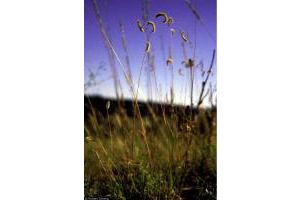Bouteloua gracilis is a native perennial bunchgrass used for livestock grazing, erosion control, and revegetation. Year-round it is grazed by wildlife, and its seeds are eaten by birds, small mammals, and insects.
Photo Credit: © Robert Soreng, USDA-NRCS PLANTS Database. Courtesy of Smithsonian Institution, Dept. of Systematic Biology, Botany.
Bouteloua gracilis
Common Name: blue grama
Plant Functional Group: Graminoid
Class > Order > Family: Magnoliopsida > Poales > Poaceae
What does the species look like?
Blue grama is an erect to spreading, perennial grass, growing 4 to 28 inches tall, and is either sod-forming or a bunchgrass. Its green flowers are tiny and inconspicuous. They are arranged in one to four, sometimes six, comb-like branches along a stem. The flowers are wind-pollinated.
Blue grama can be found in both low-lying areas and on uplands, and occurs on the plains, prairies, and foothills of most western states on rocky slopes, alluvial benches, fans, and drainages, and in scrub, woodland, and pine forests. It grows well on nearly all soil types on well-drained sites, but is not as hearty on true sands or clays. It has good cold and drought tolerance, fair salinity tolerance, and moderate alkalinity tolerance. It does not tolerate dense shade, flooding, high water tables, or acid soils.
Where is the species found?
States & Provinces
AB, AZ, BC, CA, CO, CT, FL, IA, ID, IL, KS, MA, MB, ME, MI, MN, MO, MT, ND, NE, NM, NV, NY, OH, OK, ON, SC, SD, SK, TX, UT, WI, WY
Special Considerations for Observing
If drought seems to be the cause of leaf withering for a plant, please make a comment about it for that observation.
Which phenophases should I observe?
Do you see...?
Leaves
Initial growth More...
Leaves More...
What percentage of the plant is green?
Less than 5% 5-24% 25-49% 50-74% 75-94% 95% or more
Flowers
Flower heads More...
How many fresh flower heads are present?
Less than 3 3 to 10 11 to 100 101 to 1,000 More than 1,000
Open flowers More...
What percentage of all fresh flowers (unopened plus open) on the plant are open?
Less than 5% 5-24% 25-49% 50-74% 75-94% 95% or more
Pollen release More...
How much pollen is released?
Little: Only a few grains are released. Some: Many grains are released. Lots: A layer of pollen covers your palm, or a cloud of pollen can be seen in the air when the wind blows
Fruits
Fruits Bouteloua gracilis , the fruit is a tiny grain, hidden within tiny bracts and grouped into a few short comb-like branches that are staggered along a spike-like seed head, that changes texture from soft or watery to hard and drops from the plant. Do not include seed heads that have already dropped all of their grains.More...
How many fruits are present?
Less than 3 3 to 10 11 to 100 101 to 1,000 More than 1,000
Ripe fruits Bouteloua gracilis , a fruit is considered ripe when it is hard when squeezed and difficult to divide with a fingernail, or when it readily drops from the plant when touched. Do not include seed heads that have already dropped all of their grains.More...
What percentage of all fruits (unripe plus ripe) on the plant are ripe?
Less than 5% 5-24% 25-49% 50-74% 75-94% 95% or more
Recent fruit or seed drop More...
How many mature fruits have dropped seeds or have completely dropped or been removed from the plant since your last visit?
Less than 3 3 to 10 11 to 100 101 to 1,000 More than 1,000
What do these phenophases look like?
There is currently no photoguide available for this species. If you'd like help us create one, use the guidance document and species template provided here . Then send it via email to education@usanpn.org when it is complete.
